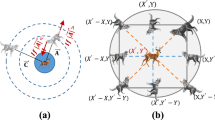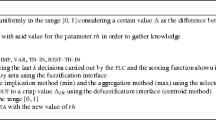Abstract
A novel genetic algorithm (GA) is proposed; a ranking genetic algorithm with improved crossover operator. The whole colony is divided into several sub-colonies, and each sub-colony is called a family, which is represented by its best individual. This algorithm includes two levels of structure: the family level and the harmonizing level. The families are parallel during the process of evolution. The harmonizing level ranks all families based on their fitness values, and transports the best individual of the first-rank family to low-grade families so as to accelerate their evolution. Two levels of competition are constructed; one among individuals of a family, and the other among families. The competition within a family is accomplished by a genetic algorithm with improved crossover operator. A family's mutation probability is determined by its relative competitive power. In this way, a rapid and global convergence to the optimum goal is obtained. The GA crossover operator is improved for the case of floating point operations. The improved crossover operator can generate child individuals at random within the space of the supercube, which enhances the space searching rate and precision. Finally, the proposed novel GA is applied to the fuzzy-variable structure control (FVSC) system of a molten carbonate fuel cell (MCFC). The simulation results are satisfying.
Similar content being viewed by others
References
Back, T., Hoffmeister, F., and Schwefel, H. P.: A survey of evolution strategies, in: Proc. 4th Internat. Conf. on Genetic Algorithms, 1994, pp. 2-9.
Chen, C. L. and Chang, M. H.: Optimal design of fuzzy sliding-mode control: A comparative study, Fuzzy Sets and Systems 93 (1998), 37-38.
Eiben, A. E. and Aarts, E. H.: Global convergence of genetic algorithms: An infinite Markov chain analysis, in: Proc. 1st Internat. Conf. on Parallel Problem Solving from Nature, 1990, 10, pp. 100-105.
Goldberg, D. E.: Real-coded genetic algorithm, virtual alphabets and blocking, Complex Systems 5 (1991), 139-167.
Hsu, L.: Smooth sliding control of uncertain systems based on a prediction error, Internat. J. Robust and Nonlinear Control 7(4) (1997), 353-372.
Kuo, T. and Hwang, S. Y.: A genetic algorithm with disruptive selection-Part B, IEEE Trans. System Man Cybernet. 26 (1996), 299-307.
Michalewicz, Z. and Janikow, C. Z.: A modified genetic algorithm for optimum control problems, Comput. Math. Appl. 23(12) (1992), 83-94.
Qi, X. and Palmieri, F.: Theoretical analysis of evolutionary algorithms with an infinite population size in continuous space-Part I, IEEE Trans. Neural Networks (1994), 102-119.
Rasheed, K.: A genetic algorithm for continuous design space search, Artificial Intelligence in Engineering 11 (1997), 295-305.
Rasheed, K. and Hirsh, H.: A genetic algorithm for continuous design space search, Artificial Intelligence in Engineering 11 (1997), 295-305.
Rudolph, G.: Convergence properties of canonical genetic algorithms, IEEE Trans. Neural Networks 5(1) (1994), 96-101.
Schraudolph, N. N. and Belew, R. K.: Dynamic parameter encoding for genetic algorithms, Machine Learning 9(6) (1992), 9-21.
Wright, A.: Genetic algorithms for real parameter optimization, in: Proc. on Foundations of Genetic Algorithms (FOGA'90), 1991, pp. 205-218.
Yamamura, M., Satoh, H., and Kobayashi, S.: An analysis of crossover's effect in genetic algorithms, in: Proc. 1st IEEE Conf. on Evolutionary Computation, 1994, pp. 613-618.
Yun, W. M. and Xi, Y. G.: Analysis of working principle of genetic algorithm, Control Theory and Application 13(3) (1996), 297-303.
Zhang, X. K., Fang, H., and Dai, G. Z.: Study on encoding mechanism of genetic algorithm, Information and Control 26(2) (1997), 134-139.
Author information
Authors and Affiliations
Rights and permissions
About this article
Cite this article
Sun, XJ., Cao, GY. & Zhu, XJ. A Novel Genetic Algorithm and its Application in Fuzzy Variable Structure Control of Fuel Cell. Journal of Intelligent and Robotic Systems 31, 299–316 (2001). https://doi.org/10.1023/A:1012091311364
Issue Date:
DOI: https://doi.org/10.1023/A:1012091311364




